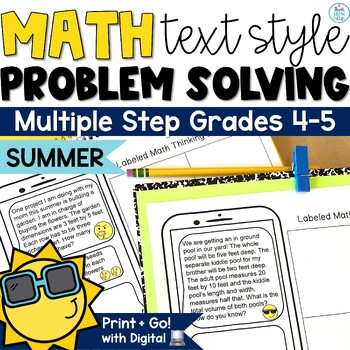Multiple Step Word Problems Multistep Mixed Operations 4th 5th 6th Grade
- Zip
- Google Apps™

Also included in
- Test prep made fun! Looking for multiple-step word problems to help your fourth and fifth graders master solving multi-step word problems? These easy-to-use and high-interest and engaging text-style problem-solving activities will keep your students motivated and critically thinking during test prepPrice $18.00Original Price $28.00Save $10.00
- Get ready for summertime in your classroom or summer school classroom with these high-interest activities! These activities are perfect for in-class learning during the last weeks of school, summer school classes, or to send home to use as summer learning packet work.This bundle includes high-interePrice $13.50Original Price $19.50Save $6.00
Description
Looking for multiple-step word problem practice for test prep or everyday use? These engaging summer-themed math word problems are written in the form of a text and require critical thinking, problem-solving, and written responses from your students.
These are perfect for the end of the year as you count down to summer or to send home with your students to complete over summer break!
Text problems cover a variety of skills, including working with fractions, measurement, multiplication, and division.
See the best-selling original Text Me Math set HERE.
Written in a text format is not only engaging for students but also requires students to write their mathematical solutions in written form to reply to the text they were sent.
These problems come in two formats. One with open space for students to organize their own work, and the second with four boxes to help students complete each step in a different box, labeling as they solve.
Great for group discussions, independent work, sub plans, morning work, homework, or any way you want students to practice problem-solving!
NOTE: Word problems were created for fourth and fifth graders and could possibly work as a challenge for third graders depending on the level of your students' abilities.
See the 3rd Grade Text Me Problems: Third Grade Text Me Word Problems
This set includes BOTH printable and digital options.
CONTENTS:
✓Link and directions use in Google Classroom™
✓10 Summer Themed Math Word Problem Sheets in Text Form
✓Answer Key included
✓Blank templates are included for students to create their own word problems. These are NOT editable files, but blank templates for students to handwrite in their own word problems for their peers to solve.
See the preview for a more detailed look at all this product has to offer.
Teacher Approved!
⭐️⭐️⭐️⭐️⭐️
Awesome resource! Any time I can get my students to explain their thinking willingly is great! :)
⭐️⭐️⭐️⭐️⭐️
"You can never have too many word problems! Such a difficult topic to teach. I'm looking forward to using these in class next year!"
⭐️⭐️⭐️⭐️⭐️
"The unique structure of this task is engaging for students. Thank you!"
⭐️⭐️⭐️⭐️⭐️
"These were so fun for my kids at the end of the year!"
You will also love...
- Text Me Math Problems
- Growth Mindset Posters
- End of Year Expert Books
- Math Alphabet Posters
- Classifying Triangles
- Waterslide Park Performance Task
Follow me HERE for notifications of new products and sales. Remember new products are always 50% off the first 24 hours!
Questions? Email me directly HERE.







